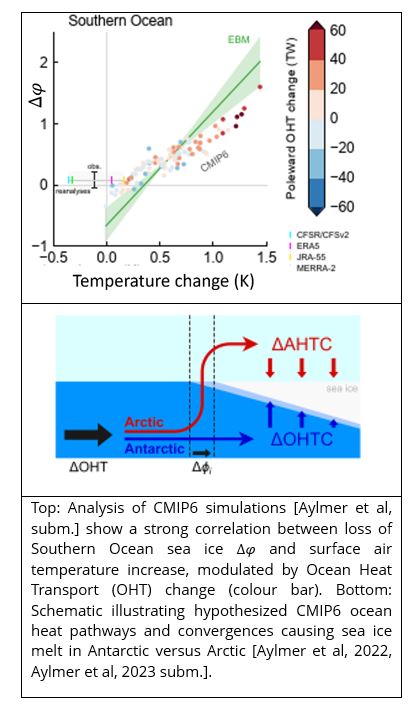Lead Supervisor: Daniel Feltham, University of Reading, Department of Meteorology
Email: d.l.feltham@reading.ac.uk
Co-supervisors: David Ferreira, Rebecca Frew, Jake Aylmer (University of Reading, Department of Meteorology)
The Southern Ocean, surrounding Antarctica in a wide swath around the globe, comprises some 30% of the global ocean surface area and accounts for uptake of around 40% of anthropogenic CO2 and 75% of global heat increases in recent decades. A dominant feature of the Southern Ocean is its sea ice cover: frozen seawater, that inhibits exchanges between the atmosphere and ocean. Changes in Southern Ocean sea ice, therefore, play a pivotal role in buffering current and future climate change in response to anthropogenic emissions.
While there has been a well-publicised reduction in Arctic sea ice, Antarctic sea ice extent has been remarkably stable until 2016/2017. Over recent years we have seen a series of record lows in Antarctic sea ice extent. At the time of writing, austral winter 2023 has been exceptionally stark due to the lack of recovery of the sea ice cover, raising concerns for the future of Antarctic sea ice. Understanding the observed trends and variability is still an open question. There is a large uncertainty in the response of Southern Ocean sea ice to anthropogenic warming and the role of natural variability.
Climate models predict sea ice loss in both poles but, as seen in the latest Coupled Model Inter-comparison Project 6 (CMIP6), they are largely unable to reproduce the observed sea ice behaviour in the Southern Ocean. Recent work by the supervisory team [see Fig. 1] reveals emergent leading order correlations in CMIP6 climate models between changes in sea ice extent , surface air temperature T, and oceanic heat transport (OHT) into the Southern Ocean.
Our previous analysis of CMIP6 models suggests different pathways of ocean heat to sea ice in the Arctic versus Antarctic (Fig. 1). The aim of this project is to go beyond our identified inter-model statistical relationships, to investigate the underlying physical causes of the changes in Antarctic sea ice. In particular, we hypothesise that OHT increases drive sea ice loss rather than vice versa.
The student will quantify atmosphere and ocean-mediated feedbacks by using and developing an atmosphere-forced ocean-sea ice numerical model (NEMO-SI3) and/or the extension of idealised energy balance models. Research questions to be addressed are:
- Does sea ice loss drive increases in OHT or do OHT increases drive ice loss? Does OHT reach the ice in surface currents or is vertical mixing needed to bring heat to the ice? Is the heat delivery to the ice approximately uniform or is it concentrated in particular regions, for example at the ice edge?
- What is the role of atmospheric triggering such as extremes in temperature or wind, such as experienced prior to the rapid ice loss event of 2016?
- What is the role of ocean preconditioning? How does subsurface heat and stratification affect ice loss, for example in the Weddell Polynya? and
- Are there critical combinations of the above factors leading to rapid ice loss?
An important outcome from this project will be an identification of climate requirements for rapid Southern Ocean sea ice loss, which will advance fundamental understanding and be of practical use to climate modelling centres.
Training opportunities:
The successful applicant will join a team of scientists working on a range of allied projects on Arctic and Antarctic sea ice, who will provide support on technical aspects of model development, simulation and analysis. The student will acquire skills in computational techniques.
Student profile:
The successful candidate will have a degree in physics, applied mathematics, engineering, or a similar numerate subject such as meteorology, along with an aptitude and enthusiasm for applying physical principles to solve real world problems and computer programming. The candidate should be able to work independently and in groups and be enthusiastic. While knowledge of the climate system, oceanography, sea ice, or meteorology would be ideal, this knowledge can be taught to the right candidate.
References:
Aylmer, Jake, Ferreira, David and Feltham, Daniel (2022) Different mechanisms of Arctic and Antarctic sea ice response to ocean heat transport. Climate Dynamics, 59. pp. 315-329. ISSN 1432-0894 doi: https://doi.org/10.1007/s00382-021-06131-x

